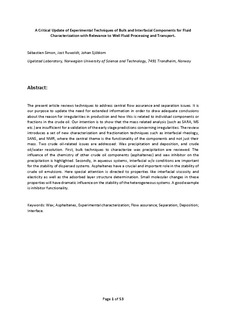| dc.contributor.author | Simon, Sebastien Charles | |
| dc.contributor.author | Ruwoldt, Jost | |
| dc.contributor.author | Sjøblom, Johan | |
| dc.date.accessioned | 2020-02-19T09:56:49Z | |
| dc.date.available | 2020-02-19T09:56:49Z | |
| dc.date.created | 2020-02-16T16:35:47Z | |
| dc.date.issued | 2020 | |
| dc.identifier.citation | Advances in Colloid and Interface Science. 2020, 277 . | nb_NO |
| dc.identifier.issn | 0001-8686 | |
| dc.identifier.uri | http://hdl.handle.net/11250/2642502 | |
| dc.description.abstract | The present article reviews techniques to address central flow assurance and separation issues. It is our purpose to update the need for extended information in order to draw adequate conclusions about the reason for irregularities in production and how this is related to individual components or fractions in the crude oil. Our intention is to show that the mass related analysis (such as SARA, MS etc.) are insufficient for a validation of the early stage predictions concerning irregularities. The review introduces a set of new characterization and fractionation techniques such as interfacial rheology, SANS, and NMR, where the central theme is the functionality of the components and not just their mass. Two crude oil-related issues are addressed: Wax precipitation and deposition, and crude oil/water resolution. First, bulk techniques to characterize wax precipitation are reviewed. The influence of the chemistry of other crude oil components (asphaltenes) and wax inhibitor on the precipitation is highlighted. Secondly, in aqueous systems, interfacial w/o conditions are important for the stability of dispersed systems. Asphaltenes have a crucial and important role in the stability of crude oil emulsions. Here special attention is directed to properties like interfacial viscosity and elasticity as well as the adsorbed layer structure determination. Small molecular changes in these properties will have dramatic influence on the stability of the heterogeneous systems. A good example is inhibitor functionality. | nb_NO |
| dc.language.iso | eng | nb_NO |
| dc.publisher | Elsevier | nb_NO |
| dc.relation.uri | https://www.sciencedirect.com/science/article/pii/S0001868619303902 | |
| dc.rights | Attribution-NonCommercial-NoDerivatives 4.0 Internasjonal | * |
| dc.rights.uri | http://creativecommons.org/licenses/by-nc-nd/4.0/deed.no | * |
| dc.title | A critical update of experimental techniques of bulk and interfacial components for fluid characterization with relevance to well fluid processing and transport | nb_NO |
| dc.type | Journal article | nb_NO |
| dc.type | Peer reviewed | nb_NO |
| dc.description.version | acceptedVersion | nb_NO |
| dc.source.pagenumber | 21 | nb_NO |
| dc.source.volume | 277 | nb_NO |
| dc.source.journal | Advances in Colloid and Interface Science | nb_NO |
| dc.identifier.doi | https://doi.org/10.1016/j.cis.2020.102120 | |
| dc.identifier.cristin | 1794490 | |
| dc.relation.project | Norges forskningsråd: 255174 | nb_NO |
| dc.relation.project | Norges forskningsråd: 237893 | nb_NO |
| dc.description.localcode | © 2020. This is the authors’ accepted and refereed manuscript to the article. Locked until 4.2.2022 due to copyright restrictions. This manuscript version is made available under the CC-BY-NC-ND 4.0 license http://creativecommons.org/licenses/by-nc-nd/4.0/ | nb_NO |
| cristin.unitcode | 194,66,30,0 | |
| cristin.unitname | Institutt for kjemisk prosessteknologi | |
| cristin.ispublished | true | |
| cristin.fulltext | original | |
| cristin.fulltext | preprint | |
| cristin.fulltext | postprint | |
| cristin.qualitycode | 1 | |

